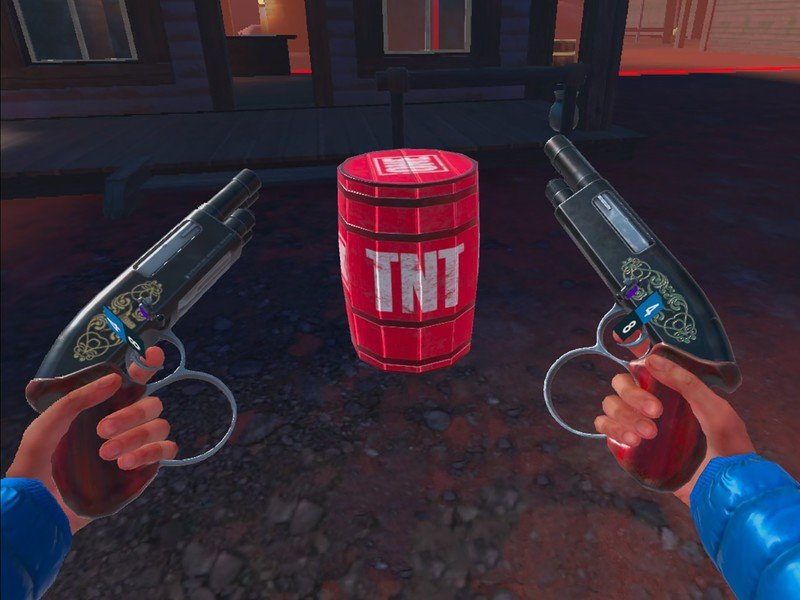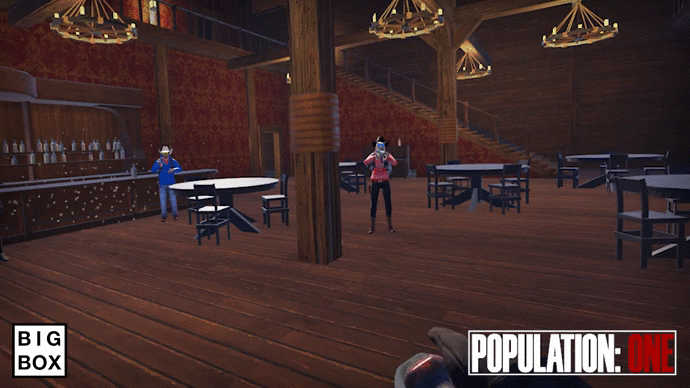Population: One Season 2 hands-on: A gun slingin' rootin'-tootin' good time

Population: One Season 1 may have just ended, but the fun has just begun. Season 2 brings about the most sweeping changes the game has yet seen, with a completely overhauled section of the map, new items, new weapons, tweaks to existing weapons, new player skins, gun skins, tags, graffiti, new game modes, a max player count increase to 24 players, and even a vastly overhauled private rooms feature. Oh, and, of course, it prominently features a western theme for much of the update. We already considered it one of the best Oculus Quest 2 games, and now it's rocketing itself to the top of the tower.
It's a more substantial update than Season 1, which, at least for me, is a very welcome thing. For this hands-on, I was invited to a special hour-long session with several BigBox VR developers — that's the crew that develops the game — as well as a few other journalists in order to experience the full 24-player experience. I also had access to a few additional play sessions scattered over the past week, giving me several hours of the new season under my belt for this hands-on. I was using the Oculus Quest 2 build of the game, which I typically use to play in my free time, anyway. Population: One Season 2 is a free expansion of the game available for all players, which runs from May 13 through late July.
If you're not familiar with Population: One, here's the rundown: Population: One started out as a battle royale shooter, much in the vein of Fortnite or other similar titles. Aside from being in VR, Population: One's biggest unique factors include the ability to climb anything — seriously, anything — and glide anywhere you want by simply spreading out your arms like wings. While they sound like relatively "simple" changes, these two mechanics alone create a surreal experience that will soon have you wondering why other games don't allow this kind of freedom of movement.
What's new in Population: One Season 2?

Building upon what Season 1 started, Population: One Season 2 changes a significant portion of the map and upgrades the maximum player count from 18 to 24; a number that allows for two additional squads in Squads mode, which, despite not sounding like much, actually tends to extend rounds quite a bit. The old cliffside area is now a western-themed town known as The Frontier, complete with mesas and a coppery desert hue. The new western town sports a big saloon in the center — featuring a self-playing piano with ragtime tunes to set the mood — and surrounding shops and a rodeo to find loot and hide out in.
The old cliffside area is now a western-themed town known as The Frontier, complete with mesas and a coppery desert hue.
A second, smaller town is located across the bridge to the train station and, littered among the plateaus and boardwalks in the town, are two new types of containers. Wooden barrels are breakable and will sometimes contain loot, while the red barrels do exactly what video games have trained us to assume for decades: explode. These red barrels are perfect for harming players that like to hide behind windowsills or above doors, as the large blast radius and high damage rate of the explosion will ensure they won't last much longer.

Littered among the random loot are three brand new items to use: the shaker bottle, the harmonica, and the Matadors. Two of the three new items are used to replenish shields; the shaker bottle tops up your personal shields by 50% each time you consume one of the items, while the harmonica is used to refill teammates' shields by playing tunes like a bard. While players won't be tossing you a coin, they'll certainly thank you if you're able to hang around them long enough to fill up those shields.
Unlike other power-up items, the harmonica isn't a one-and-done affair; it constantly refills other players' shields at the rate of a few points per second, and that rate goes up the longer you keep playing. It can even go through walls and floors, so extra-strategic players can find themselves creating some pretty impressive fortifications of healing if they're crafty enough. Just remember that it's audible from a good distance away (and only regenerates other players' shields, not yours), so someone's bound to know you're using it and figure out where the sound came from.
Get the latest news from Android Central, your trusted companion in the world of Android
Players will no doubt run for The Matadors and find the sheer joy that encompasses every blast from the end of each gun.
Players will undoubtedly run for The Matadors on their first playthrough — that's a pair of sawed-off shotguns that are also the game's first dual-wielding weapons — and find the sheer joy that encompasses every blast from the end of each gun. As you would expect from a pair of sawed-off shotguns, a close-range blast from them is devastating and is likely a better close-range weapon for most players than the knife or katana.
Be warned, though, the range for these is incredibly short, so you won't be having successful shootouts in buildings across from each other, much less any further on the map. You also won't be able to climb anything while using the Matadors since both of your hands are in use!

The Matadors also come with another fascinating new mechanic: the ability to flick to reload. Simply flick your controllers upward, and your character will spin The Matadors around their hands for a 1-second reload. It's a brilliant mechanic that feels oh-so-good — complete with a satisfying clicking sound that perfectly accompanies someone's harmonica tunes — and actually extends to two existing guns, as well. The DT11 and the .357 Magnum also support the wrist-flicking reload now, although you'll actually need to slide the bullets into the chambers of those guns before flicking.
That new western environment, which is located on the southeast corner of the map, is truly the biggest physical addition the game has yet seen. It dwarfs changes that previous events have made, as only the tower's interior felt like it added anywhere near this much new movement space. The buildings themselves are a phenomenal new strategic addition, as they're smaller and closer together than most of the other buildings scattered around the map. With that in place, you'll find the new location isn't just home to some of the best shootouts in the game; it's also the home to one of the new modes.
I also got the chance to try a few new modes that were available in this Early Access Beta, however, the team at BigBox VR is still testing out various gameplay changes that they aren't yet ready to reveal. A representative from BigBox VR said that the company would be revealing additional new content in the weeks to come.
A more substantial update

Like the previous season, Season 2 gives players 50 new levels of content to earn. Most of these unlocks are made up of graffiti and titles, but my personal highlights were the four new player skins that look wildly different from any of the stock ones. 300 Bureau Gold — or the equivalent of around $5 — is the buy-in for the Season Pass, which enables players to actually earn and unlock these skins, as well as a host of other items throughout the season. Not all items require the Season Pass buy-in, but the ones you really want to get probably do.
The new custom games feature is one that taps into a deep pit of nostalgia that many 30-something gamers like myself have: Goldeneye 64.
Population: One's new custom games feature — the game uses the name "private room" even though these rooms can be set as public — is one that taps into a deep pit of nostalgia that many 30-something gamers like myself have: Goldeneye 64. More than once in the several play sessions I took part in over the past week, did the veritable gaming legend come up, and for good reason.
Population: One's latest mode redesign puts it among the greats in the best of ways, allowing players to modify nearly every aspect of the gameplay. From restricting certain weapons during play — or just allowing one single weapon, "slappers-only" style — to reducing or increasing weapon damage, modifying movement speed to dizzying levels, and even coming up with custom game modes, this new custom games feature is a dream come true. It also features a full-scale server browser, akin to what you'd find in a game like Counter-Strike (or, I suppose, most any other PC shooter).
All of this adds up to a more substantial update than Season 1 was, bringing about not only huge changes in the game's map, weapon additions, and new mechanics, but a custom games feature that might just be the highlight of the entire experience. While matchmaking has been one of the nicer additions to modern games when you just want to play a few rounds, custom games offer players a level of control and, well, customization that simply didn't exist before. It's powerful, it's fun, and it fits right alongside what BigBox VR has been doing since the inception of Population: One: go big or go home.


